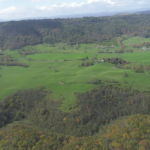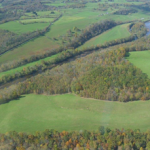Farmland Protection
Greenbrier County is the second largest land mass county in West Virginia, is losing farmland at an alarming rate. In the 1972 soil survey of Greenbrier, the county had 228,969 acres of farmland, and by 2007 that number had been reduced to 176,995 acres, a loss of 51,974 acres. Also, according to the Soil Survey of the Greenbrier County Soil Conservation Service, in 1972 the county had 1,237 farms with an average acreage of 185 acres, and according to the 2007 Census of Agriculture, this number had faIlen to 881, a loss of 356 farms. With the loss of farmland, there is a reduction of agricultural industry, which has been the heartbeat of the county’s economy for over 200 years.
Agriculture is a unique life support industry, providing sources of agricultural products for the citizens of the state. Because West Virginia’s farmland is so much less than other states, it is even more important to take steps to protect is, as it is some of the best soil suited to agricultural production in the raising of cattle, sheep, poultry and dairy animals, according to the Agricultural Census.
In addition, the Homeland Security Act, passed by Congress as a protection measure following the attack of September 11, 2000, directs that America’s farms should be protected as a means of security. According to the American Farmland Trust, because of the enormous loss of farmland nationwide during the last 40 years, the United States is no longer agriculturally self sufficient. Thus, America’s security is enhanced by the protection of farmland in the event that terrorist attacks prevent the importation of necessary agricultural goods from other countries.
Our Local Program
West Virginia is unique in that it has a lower ratio of farmland to land mass than many other states. Thus, the preservation of farmland in our state is even more critical. In recognition of the importance of agricultural production to our state, in 2004, the West Virginia legislature implemented the Farmland Preservation Act. To date, twenty West Virginia counties have implemented a voluntary farmland protection program under this important legislation.
Under the 2004 legislation, the Greenbrier County Commission created the Greenbrier County Farmland Protection Board and designated a portion of the county real estate transfer tax to fund acquisitions. By the end of 2010, over 1,550 acres of farmland have been protected in Greenbrier County under conservation easements held by the Greenbrier County Farmland Protection Board.
The Greenbrier County Farmland Protection Board has established guidelines for its protection of farmland. The guidelines are published in the Greenbrier County Farmland Protection Program document. All protection of farmland under the Program is voluntary, and to be considered, the landowner must offer to place his or her farmland in a conservation easement. The Greenbrier County Farmland Protection Board protects agricultural land by acquiring a conservation easementon the property. Among other things, the conservation easement prohibits any further development or subdivision of the protected land.
Landowners may offer to sell or donate a conservation easement on their land to the Greenbrier County Farmland Protection Board. The Board may pay a landowner for a conservation easement on land that meets the Program criteria, up to the appraised value of a the conservation easement. However, because the Board has limited financial resources, it cannot accept all offers to sell an easement. Landowners offering to donate a conservation easement on their land may also be able to take advantage of the tax benefits from such a donation.
In an effort to create a local program to provide farm owners a voluntary land conservation option, the Greenbrier County Commission on July 17, 2002 created the Greenbrier County Farmland Protection Board. The Farmland Protection Board is charged with creating a document proposing a farmland protection program consistent with the Legislature’s intent and to seek funding to implement such a program.
This program establishes uniform standards and guidelines for the eligibility of properties and the ranking criteria utilized to prioritize funds allocation to purchase conservation easements, or to pay associated costs for the purchased or donated easements. The guidelines established by this program outline the various methods of farmland protection available to prospective participating property owners, and the procedures to be followed in applying for program consideration.
| Amy Moloney
Greenbrier Valley Economic Development Corp. FARMLAND PROTECTION 804 Industrial Drive Maxwelton, WV 24957 Email: email |
912 Court Street N. Lewisburg, WV 24901 Phone: 304-497-4300 (leave message) Fax: 304-647-6650 greenbrierland@frontier.com |
For more information or applications- greenbrierland@frontier.com
- Arial 1
- Arial 2
- Arial 3



